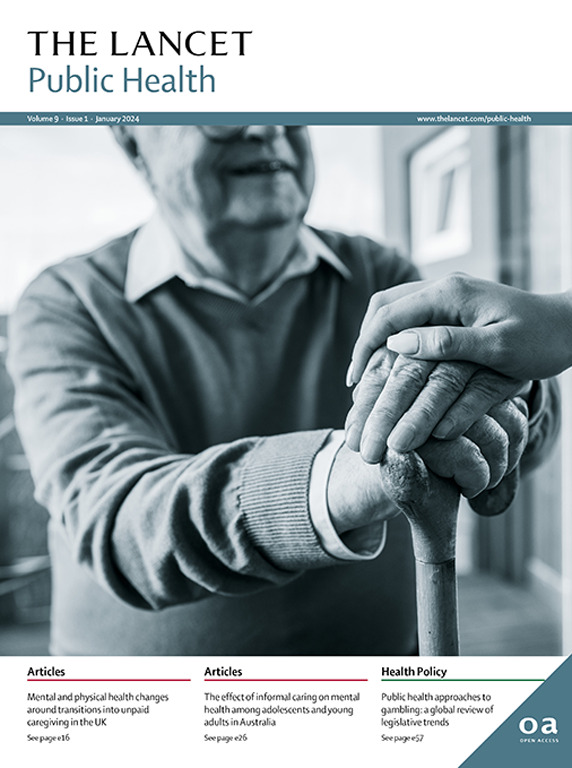Estimated health effect, cost, and cost-effectiveness of mandating sodium benchmarks in Australia's packaged foods: a modelling study
IF 25.4
1区 医学
Q1 PUBLIC, ENVIRONMENTAL & OCCUPATIONAL HEALTH
引用次数: 0
Abstract
Background
Excess dietary sodium is a leading cause of death and disability globally. Because packaged foods are a major source of sodium in many countries, including Australia, mandatory limits for sodium might improve population health. We aimed to estimate the long-term health and economic effect of mandating such thresholds in Australia.Methods
We used a multiple cohort, proportional, multistate, life table model to simulate the effect of mandating either the WHO global sodium benchmarks or the currently non-mandatory Australian Healthy Food Partnership (HFP) sodium targets. We compared maintaining the current sodium intake status quo with intervention scenarios, using nationally representative data on dietary intake, sodium in packaged foods, and food sales volume. Blood pressure and disease burden data were obtained from the Global Burden of Diseases, Injuries, and Risk Factors Study. The effect of sodium reduction on blood pressure and disease risk was modelled on the basis of meta-analyses of randomised trials and cohort studies. Intervention and health-care costs were used to calculate the incremental cost per health-adjusted life-year (HALY) gained. Costs and HALYs were discounted annually at 3%.Findings
Compared with the status quo intervention, mandating the WHO benchmarks could be cost saving over the first 10 years (AUD$223 [95% uncertainty interval 82–433] million saved), with 2743 (1677–3976) cardiovascular disease deaths and 43 971 (26 892–63 748) incident cardiovascular disease events averted, and 11 174 (6800–16 205) HALYs gained. Over the population's lifetime, the intervention was cost effective (100·0% probability). Mandating the HFP sodium targets was also estimated to be cost effective (100·0% probability), but with 29% of the health benefits compared with the WHO benchmarks.Interpretation
Our modelling study supports mandating sodium thresholds for packaged foods as a cost-effective strategy to prevent death and disease in Australia. Although making Australia's voluntary reformulation targets mandatory might save thousands of lives, mandating the WHO global benchmarks could yield substantially greater health gains.Funding
None.澳大利亚包装食品中钠含量基准的健康影响、成本和成本效益估算:模型研究
背景膳食钠超标是导致全球死亡和残疾的主要原因。由于在包括澳大利亚在内的许多国家,包装食品是钠的主要来源,因此强制限制钠的摄入量可能会改善人口健康。我们使用了一个多队列、比例、多州、生命表模型来模拟强制执行世界卫生组织全球钠基准或目前非强制执行的澳大利亚健康食品伙伴关系(HFP)钠目标的效果。我们利用具有全国代表性的膳食摄入量、包装食品中的钠含量和食品销售量数据,对维持当前钠摄入量现状和干预方案进行了比较。血压和疾病负担数据来自《全球疾病、伤害和风险因素负担研究》(Global Burden of Diseases, Injuries, and Risk Factors Study)。根据对随机试验和队列研究的荟萃分析,模拟了降钠对血压和疾病风险的影响。干预和医疗成本用于计算每获得健康调整生命年 (HALY) 的增量成本。研究结果与维持现状的干预措施相比,强制执行世界卫生组织的基准可在最初 10 年内节约成本(节约 2.23 亿澳元[95% 不确定区间为 8,200-4.33 亿澳元]),避免 2743 例(1677-3976 例)心血管疾病死亡和 43971 例(26,892-63,748 例)心血管疾病事件,并获得 11,174 个(6,800-16,205 个)健康调整寿命年。在人口的一生中,干预措施具有成本效益(概率为 100-0%)。据估计,强制规定 HFP 的钠含量目标也具有成本效益(概率为 100-0%),但与世界卫生组织的基准相比,健康效益仅为后者的 29%。尽管强制实施澳大利亚的自愿重新制定目标可能会挽救成千上万人的生命,但强制实施世界卫生组织的全球基准可能会产生更大的健康收益。
本文章由计算机程序翻译,如有差异,请以英文原文为准。
求助全文
约1分钟内获得全文
求助全文
来源期刊

Lancet Public Health
Medicine-Public Health, Environmental and Occupational Health
CiteScore
55.60
自引率
0.80%
发文量
305
审稿时长
8 weeks
期刊介绍:
The Lancet Public Health is committed to tackling the most pressing issues across all aspects of public health. We have a strong commitment to using science to improve health equity and social justice. In line with the values and vision of The Lancet, we take a broad and inclusive approach to public health and are interested in interdisciplinary research.
We publish a range of content types that can advance public health policies and outcomes. These include Articles, Review, Comment, and Correspondence. Learn more about the types of papers we publish.
 求助内容:
求助内容: 应助结果提醒方式:
应助结果提醒方式:


